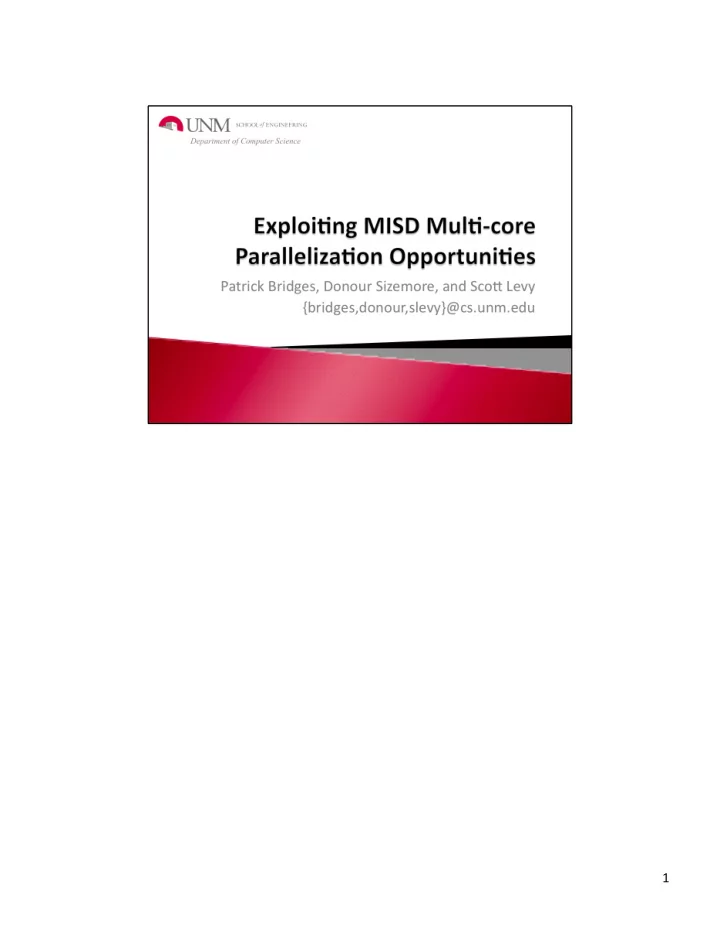

1 ¡
UNM ¡CS ¡has ¡a ¡history ¡of ¡pulling ¡ideas ¡from ¡a ¡diverse ¡set ¡of ¡area ¡and ¡pu:ng ¡them ¡ together ¡in ¡unusual ¡ways ¡to ¡solve ¡problems. ¡ 2 ¡
3 ¡
Current ¡system ¡so@ware ¡focuses ¡on ¡ weak ¡scaling ¡where ¡ workload ¡grows ¡with ¡ processor ¡count ¡-‑ ¡More ¡processes, ¡open ¡files, ¡network ¡connecFons ¡ Minimal ¡work ¡on ¡ strong ¡scaling ¡ in ¡ system ¡so@ware ¡-‑ ¡Fixed ¡workload ¡executed ¡ faster ¡ with ¡more ¡processors. ¡That ¡means ¡faster ¡individual ¡network ¡connecFons, ¡file ¡system ¡ updates, ¡etc. ¡ Strongly ¡scalable ¡OS ¡services ¡increasingly ¡important ¡-‑ ¡without ¡it, ¡we ¡either ¡complicate ¡ the ¡work ¡of ¡the ¡applicaFon ¡programmer, ¡or ¡worse, ¡limit ¡the ¡services ¡available ¡them ¡ completely. ¡ Example: ¡Strongly ¡scalable ¡single ¡TCP ¡connecFons. ¡ ¡ A ¡single ¡TCP ¡connecFos ¡already ¡boOlenecks ¡on ¡CPU ¡speeds, ¡especially ¡at ¡tradiFonal ¡ MTUs ¡ Real ¡parallelizaFon ¡opportuniFes: ¡data ¡delivery, ¡ack ¡generaFon, ¡Fmer ¡expiry, ¡etc. ¡ ¡ Small ¡but ¡important ¡inter-‑request ¡dependencies: ¡window ¡state ¡maintenance ¡ Very ¡fine-‑grained ¡units ¡of ¡parallelizaFon: ¡1500 ¡byte ¡packets ¡ SynchronizaFon ¡kills ¡single ¡connecFon ¡performance ¡at ¡this ¡granularity! ¡ Linux ¡TCP ¡connecFons ¡faster ¡with ¡1 ¡core ¡than ¡2 ¡or ¡more ¡ Solaris ¡doesn’t ¡even ¡try ¡to ¡parallelize ¡individual ¡connecFons ¡ Well-‑studied: ¡Bjorkman ¡1993, ¡Nahum ¡1994, ¡Willman ¡2006 ¡ 4 ¡
Why ¡haven’t ¡we ¡been ¡able ¡to ¡solve ¡this? ¡ First: ¡We ¡use ¡MIMD ¡parallelism: ¡Related ¡requests ¡split ¡across ¡available ¡cores ¡and ¡ shared ¡state ¡accessed ¡via ¡locks, ¡IPC, ¡transacFons, ¡etc. ¡ We ¡generally ¡use ¡classic ¡MIMD ¡parallelism, ¡which ¡relies ¡on ¡explicit ¡synchronizaFon/ communicaFon ¡between ¡processors. ¡That’s ¡expensive ¡compared ¡to ¡the ¡unit ¡of ¡work ¡ at ¡which ¡we ¡want ¡to ¡parallelize ¡some ¡of ¡these ¡services. ¡ So ¡why ¡haven’t ¡the ¡latest ¡and ¡greatest ¡“special ¡snowflake” ¡synchronizaFon ¡ mechanisms ¡solved ¡this ¡problem? ¡ ¡ The ¡issue ¡is ¡deeper ¡than ¡that! ¡What ¡happens ¡as ¡you ¡add ¡cores ¡in ¡MIMD ¡parallelism? ¡ 5 ¡
Simply ¡using ¡a ¡“beOer” ¡synchronizaFon ¡method ¡isn’t ¡good ¡enough ¡– ¡MIMD ¡ fundamentally ¡requires ¡explicitly ¡coordinaFng ¡N ¡acFviFes, ¡and ¡the ¡cost ¡of ¡that ¡grows ¡ quickly. ¡ ¡Each ¡core ¡you ¡add ¡reduces ¡parallelizable ¡work ¡that ¡has ¡to ¡be ¡done ¡on ¡other ¡cores ¡but ¡ increases ¡synchronizaFon ¡costs ¡on ¡ all ¡processors ¡(lock ¡contenFon, ¡IPC ¡latency, ¡ transacFon ¡rollbacks, ¡etc.) ¡ ¡ As ¡you ¡add ¡cores, ¡the ¡increase ¡in ¡synchronizaFon ¡overhead ¡is ¡quadraFc ¡but ¡the ¡ benefit ¡is ¡linear ¡– ¡at ¡high ¡core ¡counts, ¡any ¡non-‑zero ¡amount ¡of ¡explicit ¡ synchronizaFon ¡will ¡kill ¡your ¡performance! ¡ MIMD ¡Parallelism ¡kills ¡strong ¡scaling! ¡ 6 ¡
So, ¡we ¡need ¡to ¡avoid ¡explicit ¡synchronizaFon ¡but ¡sFll ¡deal ¡with ¡non-‑trivial ¡inter-‑ request ¡dependencies ¡ We ¡repurpose ¡a ¡well-‑known ¡technique ¡from ¡parallel ¡and ¡distributed ¡compuFng ¡to ¡ address ¡this ¡problem: ¡MISD ¡parallelizaFon, ¡that ¡is, ¡replicaFng ¡not ¡just ¡state ¡across ¡ cores ¡as ¡in ¡K42, ¡Tornado, ¡and ¡Barrellfish, ¡but ¡also ¡replicaFng ¡work ¡on ¡all ¡requests ¡on ¡ all ¡cores. ¡ ¡ So ¡how ¡do ¡we ¡get ¡speedup? ¡Like ¡some ¡parallel ¡algorithms ¡and ¡unlike ¡in ¡most ¡classic ¡ distributed ¡systems, ¡we ¡replicate ¡only ¡the ¡sequenFal ¡work ¡on ¡all ¡cores. ¡Parallelizable ¡ work ¡is ¡not ¡replicated ¡and ¡is ¡sFll ¡split ¡across ¡cores! ¡ ¡ EssenFally, ¡we’re ¡replacing ¡locking ¡around ¡sequenFal ¡work ¡with ¡doing ¡all ¡the ¡ sequenFal ¡work ¡everywhere. ¡This ¡works ¡well ¡whenever ¡it’s ¡cheaper ¡to ¡“just ¡do ¡it ¡ again” ¡than ¡to ¡do ¡explicit ¡synchronizaFon. ¡ ¡ BeOer ¡for ¡fine-‑grained ¡workloads ¡where ¡any ¡synchronizaFon ¡is ¡prohibiFve, ¡or ¡with ¡ large ¡core ¡counts. ¡Unlike ¡MIMD, ¡a ¡new ¡core ¡adds ¡new ¡replicated ¡work ¡(overhead) ¡ only ¡on ¡that ¡new ¡core, ¡not ¡the ¡previously-‑exisFng ¡cores. ¡So, ¡MISD ¡overheads ¡grow ¡ linearly ¡with ¡increased ¡core ¡counts ¡instead ¡of ¡quadraFcally. ¡ 7 ¡
The ¡result ¡of ¡this ¡is ¡that ¡for ¡fine-‑grained ¡workloads, ¡which ¡we ¡expect ¡to ¡be ¡common ¡ in ¡system ¡so@ware, ¡a ¡MISD-‑based ¡approach ¡tracks ¡the ¡best ¡possible ¡performance ¡as ¡ given ¡by ¡Amdahl’s ¡law ¡much ¡beOer ¡than ¡approaches ¡based ¡on ¡explicit ¡ synchronizaFon. ¡ 8 ¡
Dominoes: ¡Framework ¡for ¡MISD ¡System ¡Services ¡ Broadcast ¡ FIFO ¡channels ¡to ¡distribute ¡requests ¡ Publish/subscribe ¡event-‑based ¡programming ¡model ¡ More ¡framework ¡details ¡in ¡paper ¡ PorFng ¡Scout ¡TCP/IP ¡Stack ¡to ¡Dominoes ¡ Single-‑threaded ¡stack ¡easy ¡to ¡integrate ¡and ¡parallelize ¡ Evaluate ¡difficulty ¡of ¡using ¡MISD ¡parallelizaFon ¡with ¡a ¡single-‑threaded ¡event-‑based ¡ service ¡ IniFal ¡result: ¡First-‑ever ¡strong-‑scaling ¡of ¡TCP ¡receive ¡processing ¡ 1.8x ¡improvement ¡in ¡TCP ¡receive ¡throughput ¡using ¡4 ¡cores ¡ TCP ¡Send ¡is ¡harder ¡ Working ¡on ¡opFmized ¡zero-‑copy ¡library-‑level ¡implementaFon ¡ Only ¡modest ¡changes ¡to ¡scout ¡to ¡get ¡it ¡to ¡run ¡in ¡dominoes ¡ 9 ¡
High-‑throughput ¡file ¡system ¡and ¡data ¡services ¡ Replicate ¡in-‑memory ¡metadata ¡(FS ¡state, ¡buffer ¡cache ¡info) ¡ Parallelize ¡data ¡manipulaFon ¡ Virtual ¡machine ¡services ¡ Shared ¡virtual ¡devices ¡– ¡virtual ¡network ¡switches ¡ Memory ¡page ¡de-‑duplicaFon ¡and/or ¡compression? ¡ Parallel ¡OS ¡services ¡on ¡GPUs ¡ MISD ¡replicaFon ¡can ¡leverage ¡large ¡amounts ¡of ¡parallelism ¡ Without ¡the ¡locks ¡that ¡are ¡prohibiFve ¡on ¡GPUs ¡ 10 ¡
11 ¡
Solving ¡these ¡problems ¡without ¡parallelism ¡(or ¡protocol ¡changes!) ¡means ¡exponenFal ¡ increases ¡somewhere ¡else ¡– ¡for ¡example ¡in ¡MTU, ¡ ¡ 12 ¡
Recommend
More recommend